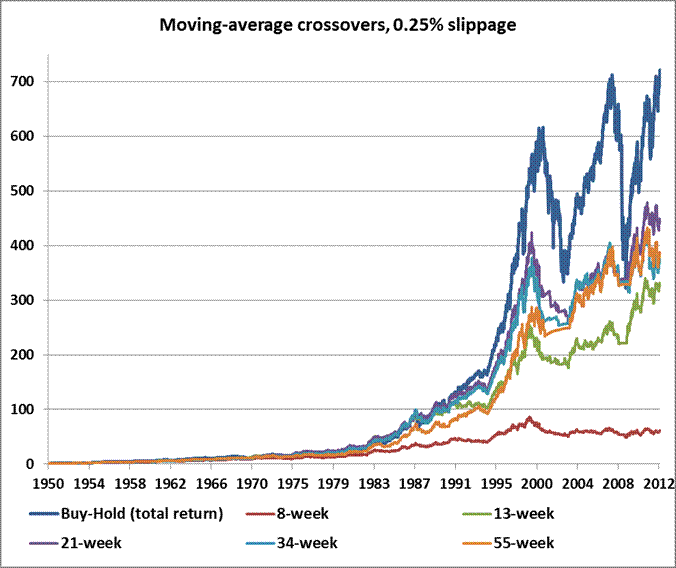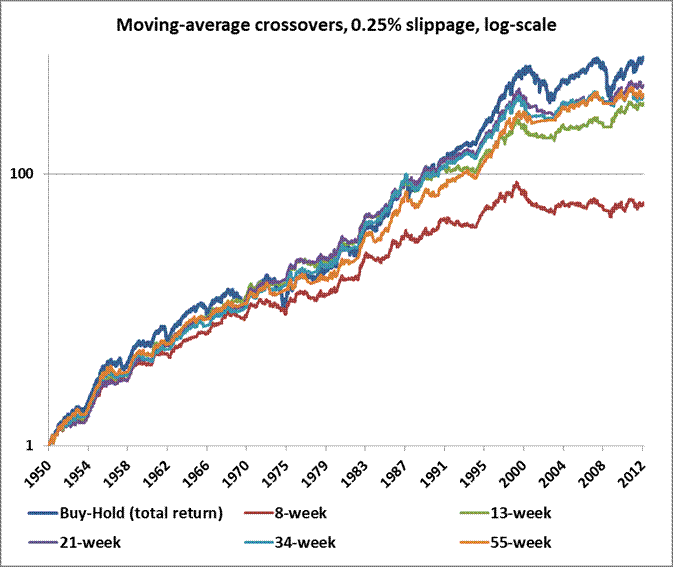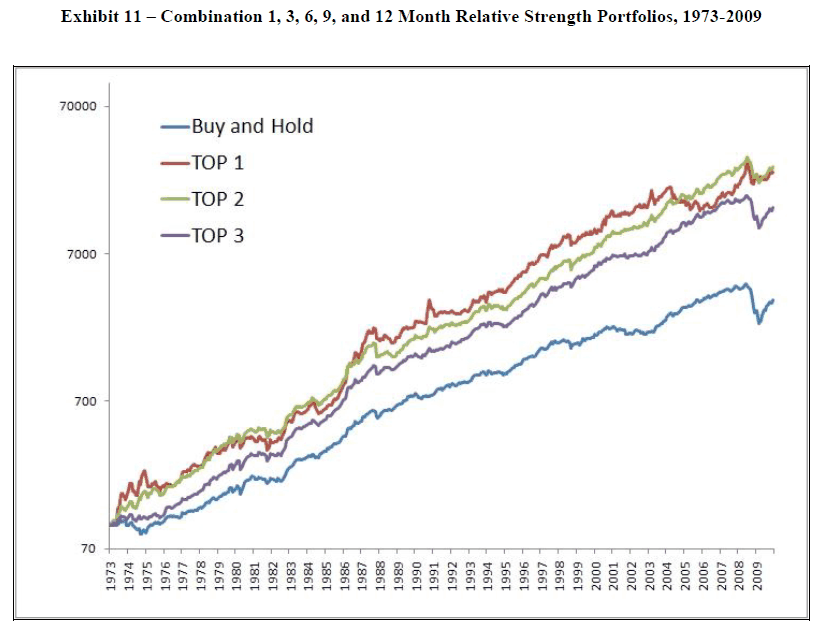Re-balance Cycle Reminder
Based on our monthly re-balance calendar, the next re-balance time will be on Monday, September 10, 2012. You can also find the re-balance calendar of 2012 on ‘My Portfolios’ page.
As a reminder to expert users: advanced portfolios are still re-balanced based on their original re-balance schedules and they are not the same as those used in Strategic and Tactical Asset Allocation (SAA and TAA) portfolios of a plan.
Also please note that we now list the next re-balance date on every portfolio page.
New Features
We have been working non-stop to improve our system. We finally replaced the ugly and incomprehensible ‘My Portfolios’ with the newly introduced ‘Dashboard’ page. Expect to see more substantial changes and improvements in the coming weeks.
Trends Can Be Fickle
As usual, John Hussman had a nice discussion on trend following strategies in his latest weekly commentary The Trend is Your Fickle Friend. He discussed his back testing results on using moving averages as timing indicators. Taking slippage and/or tax into account, he showed the following chart:
So indeed, the trend is your fickle friend: from 1950 to now, the strategy with various parameters did not beat the buy and hold.
He further noted that the 8-week moving average strategy has the largest maximum drawdown: 45%! This can be seen better in the log scale chart:
His conclusion:
Does all of this suggest that trend-following measures should be ignored? Not at all – but it does emphasize that simple trend-following schemes (like moving-average crossover rules) are unlikely to be very effective in isolation, and are not usefully applied as a top-level filter in the hope of catching market rallies without being vulnerable to downside risk. Typically, the best that can be achieved with popular moving-average crossover systems is a moderate reduction in drawdown risk, but zero or negative incremental long-term return versus a buy-and-hold.
He further went on to discuss his multi-sensor approach to trend following.
This is consistent with what MyPlanIQ has stated repeatedly: an all-in/all-out stock timing does not work effectively. However, when trend following technique is used for multiple assets that are not much correlated (such as stocks, bonds, commodities, real estate), it has been shown to be much more effective. The Tactical Asset Allocation(TAA) is a show case for this type of ‘relative strength’ strategies.
Fortunately, there have been many studies on the relative strength strategy that go back to many years. We cite the following two studies:
Mebane Faber’s Relative Strength Studies
In the study titled as Relative Strength Strategies for Investing, Faber did back testing using 1,3,6,9 and 12 month relative strength individually and their combination. He showed the following chart for the combination strategy:
This clearly shows the relative strength strategy is working well in the period studied.
Gary Antonacci’s Relative Strength Studies
Gary Antonacci further improved the multiple asset class relative strength strategy but applying the momentum to efficient frontier finder for asset allocation. In the latest study, his improved method performed very well in the period between 1974 to 2011 (similar to Faber’s period).
Finally, a classic study on this subject by Clifford Asness, Tobias Moskowitz and Lasse Pedersen Value and Momentum Everywhere.
Fickle Trends Can Be Your Friends
From Hussman’s study on all-in/all-out single indicator (moving average) based timing to several ‘impressive’ relative strength studies, we can conclude that Trends Can Still Be Your Friends, though Fickle.
However, even the trend following in a diversified list of assets, there is no guarantee that it will achieve consistent market beating result all the time. This is evident for the TAA portfolios’ performance in 2011 and even year to date in this year (2012). What it counts, however, is that through market cycles such as a full bull-bear period, one can expect this type of strategies excel while in the bull period, it still works reasonably well (not necessarily beating market indices).
It also leads to our long standing position: the best investment strategy should have both core (strategic) and satellite (dynamic) components (so called core satellite portfolios). We discussed this in our previous newsletter February 27th 2012: Core Satellite Portfolios And Static Portfolios. The newsletter lists several previous articles we wrote on this subject.
Market Overview
Our position has not changed: We still maintain our cautious attitude to the recent stock market strength. Again, we have not seen any meaningful or substantial structural change in the U.S., European and emerging market economies. However, we will let markets sort this out and will try to take advantage over its irrational behavior if it is possible.
From 360° Market Overview, one can see the current major asset classes are very divergent: the last week’s weakness of emerging market stocks (VWO) has again pushed its ranking to the bottom position, even below the Treasury Bills (SHV)’s ranking. Market trends are not uniform at all.
We again would like to stress for any new investor and new money, the best way to step into this kind of markets is through dollar cost average (DCA), i.e. invest and/or follow a model portfolio in several phases (such as 2 or 3 months) instead of the whole sum at one shot.
Portfolio Review
The following reviews the performance of several advanced portfolios on ‘Advanced Users‘ page:
Portfolio Performance Comparison (as of 8/27/2012)
| Portfolio/Fund Name | 1 Week Return* |
YTD Return** |
1Yr AR | 1Yr Sharpe | 3Yr AR | 3Yr Sharpe | 5Yr AR | 5Yr Sharpe |
|---|---|---|---|---|---|---|---|---|
| P Bond Funds Momentum Based on Upgrading Fixed Income Managers of the Year`s Funds Monthly | 0.3% | 5.7% | 7.9% | 251.8% | 10.3% | 249.7% | 10.1% | 202.4% |
| P No Load Conservative Mutual Funds Upgrading Quarterly | 0.8% | 3.4% | 0.2% | 9.2% | 6.8% | 125.9% | 8.5% | 132.5% |
| P Doug Roberts Follow the Fed Add Treasury Note One Month Simple Indicator Moving Average 64 Days | 0.9% | 6.5% | 2.9% | 36.7% | 13.8% | 127.2% | 10.1% | 79.1% |
| VBINX | -0.0% | 9.3% | 15.1% | 135.1% | 10.8% | 98.3% | 4.4% | 23.1% |
| P Goldman Sachs Global Tactical Include Emerging Market Diversified Bonds | 1.8% | 4.4% | 10.3% | 111.2% | 11.6% | 75.7% | 11.7% | 77.0% |
*: NOT annualized
**YTD: Year to Date
See more detailed and latest comparison >>
Latest Articles
- Tax Loss Harvesting: Five Tips to Keep More of What’s Yours
- The False Promises of Annuities and Annuity Calculators
- Economic Data Continues to Refute ECRIs Recession Call by Doug Short of Advisor Perspectives (dshort.com)
- Fine Wine Price Continues To Decline While Stocks Rise
- For Marc Faber The Iron ‘Ore’ Lady Has Sung
- The End of ‘The Cult of Equity’?
- The Disciplined Pursuit of Less
- Paulson’s & Soros’ GLD Blunder
- Baltic Dry Ship Index At 2008-2009 Low Since May
- AAII Asset Allocation Model Portfolios Review
- The Power of Effective Diversification: Part II
- PIMCO’s Scot Mather & Dirk Jeschke: Japanification
- AAII Bullish Sentiment Surges to Highest Level Since March
- What Will Be Obvious 20 Years From Now? (With a Sharpe of 0.76)?
- Tax Loss Harvesting: Share Your Pain with Uncle Sam
- Mexico: The Forgotten Emerging Market
- Richard Russell – Something Evil And Bearish In The Guts Of This Market
- Ten Charts That Show Sentiment Is Anything But Bearish
- Permanent Portfolio Shakedown Part 1 by Adam Butler, Mike Philbrick of Butler|Philbrick|Gordillo & Associates
- The Trend is Our Friend: Risk Parity, Momentum and Trend Following in Global Asset Allocation
- August 20, 2012: Financial Crises, National Crises, World Crises And Diversification
How can we improve this newsletter — we value your inputs –Thanks to those who have already contributed — we appreciate it.





 Diversified Asset Allocation Portfolios For Your Plans
Diversified Asset Allocation Portfolios For Your Plans

John Hussman’s article is actually shocking to me. I have been going by
trend following since about 2009, and all of my research showed that it
was pretty good. After reading that article I tried to duplicate his
results. I could only get data back to 1987, not back to 1950, however
the result was clear — Trend following can reduce the volatility of a
portfolio, avoiding most of the horrible drops of 2008 and 2001.
However, it misses out on a lot of the gains. If your backtest
experiments are only 10 to 12 years long, trend following looks just
great. If you include the boom years of the 1990’s and late 1980, trend
following Stinks!
Okay, so it reduces volatility. Surely adding
a little margin would help? My experiments, much to my surprise, show
that adding a lot of margin hurts a lot (both to a trend following and
“buy and hold”), and adding a little margin hurts a little. I
understand the buy and hold not liking margin — my experiment could
“rebalance” once a year. That is, if the portfolio was not as far out
on margin as the goal it would buy more. If it was too far out on
margin it would sell some. That directly means buy more when stock
prices are high and sell some when stock prices are low. I don’t
understand why it didn’t work with a trend following portfolio.
MyPlanIQ seems to do a lot of 5 to 10 year backtesting….
Thanks for the good observation and testing. Here are several key points to remember:
1). Hussman did all in and all out testing on S&P 500 index using moving average (MA).
2). relative strength is a loose term: it could be used at 3 levels
a. a group of stocks.
b. a group of industries or sectors or stock styles (such as large, mid and small caps).
c. a group of diversified assets (such as stocks, bonds, reits).
So when people test and state the results of ‘relative strength’, you have to know in more detail what they mean. Our research indicated
1 and 2.a and 2.b are very fickle (as Hussman pointed out) but 2.c is robust.
This is validated by both Faber’s and Antonacci’s results.
Here is another much longer portfolio using Goldman Sachs Global Tactical: the start date is 6/28/1991 so we have about 21 years and going for this one.
http://www.myplaniq.com/LTISystem/jsp/portfolio/ViewPortfolio.action?ID=39,067
We will discuss the issues related to the above in the coming newsletter as we think they are very important and confusing (by noises too).
Thanks,
John